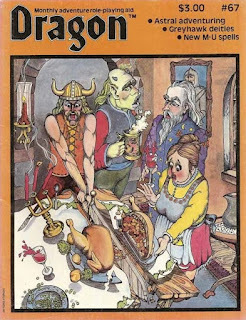The Articles of Dragon: "The Deities & Demigods of the World of Greyhawk"
 Issue #67 of Dragon (November 1982) is another one featuring more than one article that made a lasting impression on me. The first of these is Gary Gygax's "The Deities & Demigods of the World of Greyhawk." Now, given my rather mixed to negative feelings about Deities & Demigods itself, you'd think I'd feel similarly about this article (and its follow-ups in subsequent issues) as well. However, you'd be mistaken in that assumption and the reason why is, I think, worth discussing.
Issue #67 of Dragon (November 1982) is another one featuring more than one article that made a lasting impression on me. The first of these is Gary Gygax's "The Deities & Demigods of the World of Greyhawk." Now, given my rather mixed to negative feelings about Deities & Demigods itself, you'd think I'd feel similarly about this article (and its follow-ups in subsequent issues) as well. However, you'd be mistaken in that assumption and the reason why is, I think, worth discussing.I have a lot of criticisms of Deities & Demigods, but one I haven't talked about as often as I should is how dull it is. The book presents more than a dozen pantheons for use with Advanced Dungeons & Dragons, but the bulk of that presentation is given over to game statistics of the gods rather than information about the beliefs, practices, and role of those gods' worship. That's the kind of thing I wanted out of the book, not Monster Manual-style write-ups of Zeus or Odin. Making the Greek and Norse gods boring is quite the feat, especially for someone like myself, who adored their myths and legends and yet, somehow, Deities & Demigods managed to do it.
"The Deities & Demigods of the World of Greyhawk," unfortunately, still devotes too much space to game statistics. On the other hand, Gygax provides more than that, peppering his descriptions of the four featured gods – Heironeous, Hextor, Iuz, and St. Cuthbert – with information on their worshipers, temples, and place in society, not to mention tidbits of Greyhawk-specific mythology in which they appear. In these descriptions, he's fleshing out the World of Greyhawk setting in a way he never did in its original folio release. That was a big part of the appeal of this article for me: learning more about the details of what had previously been a very bare bones setting, including its myths and folklore.
It didn't hurt that the gods Gygax chose to highlight in this first article were genuinely interesting ones. In the case of St. Cuthbert, he had finally answered questions I'd had ever since I first opened my copy of the Dungeon Masters Guide and read the artifacts section where he discusses the Mace of St. Cuthbert. Likewise, Iuz was one of the few divine (or demonic) beings mentioned by name in The World of Greyhawk, where he is simply called "Lord of Evil." Nothing else is said about him, so I was largely left to imagine who Iuz might be until this article appeared. Heironeous and Hextor, on the other hand, were completely new to me, having never come across any references to them beforehand. These quarreling half-brothers, one good and one evil, made quite the pair and the divine rivalry had consequences for Greyhawk and its inhabitants.As I said, Gygax still wastes far too much verbiage on game statistics – statistics that, in my experience, are almost never used in actual play. I don't really understand why AD&D went to the trouble of codifying the armor class, hit points, attacks, etc. of the gods. I can only assume that, by the time this article appeared, doing so was already well enough established that Gygax didn't consider another approach, one that focuses less on game stats and more on the role the gods played within the imaginary setting of Greyhawk. That's a shame, because I think it's a more fruitful approach – or at least one I would have enjoyed more.
Even so, "The Deities & Demigods of the World of Greyhawk" manages to pack a fair bit of setting-specific information in its entries, which I enjoyed. This article and the ones that followed were among my favorites in the pages of Dragon during the early 1980s. They gave the World of Greyhawk some much needed details about its gods and religions, a topic I've long enjoyed. But it was this first article that I remember most vividly, hence its inclusion in this series.
Published on November 11, 2024 21:00
No comments have been added yet.
James Maliszewski's Blog
- James Maliszewski's profile
- 3 followers
James Maliszewski isn't a Goodreads Author
(yet),
but they
do have a blog,
so here are some recent posts imported from
their feed.



